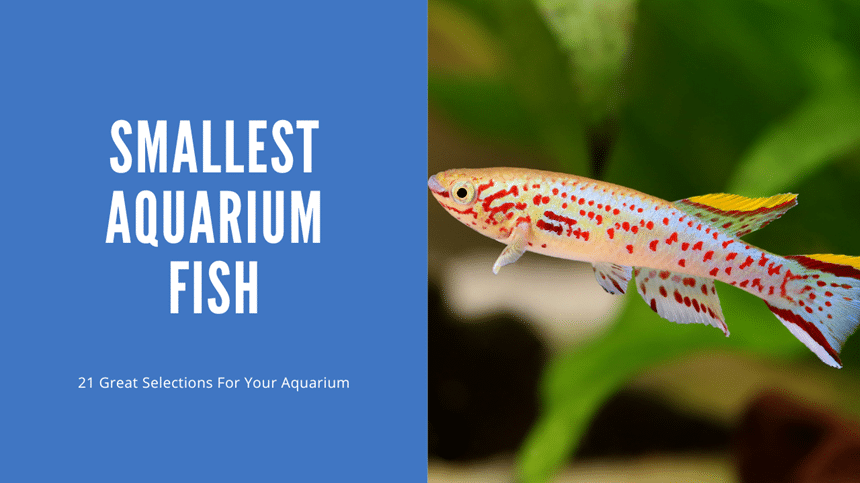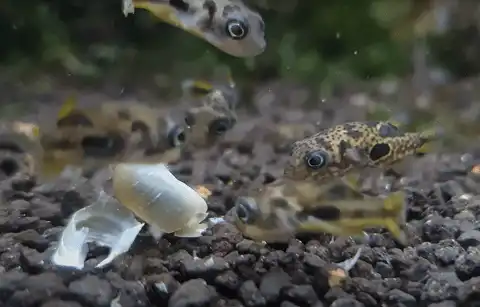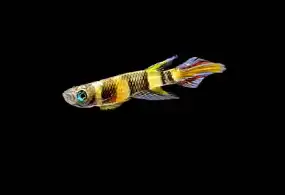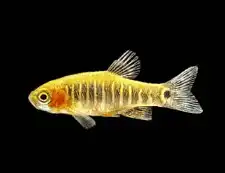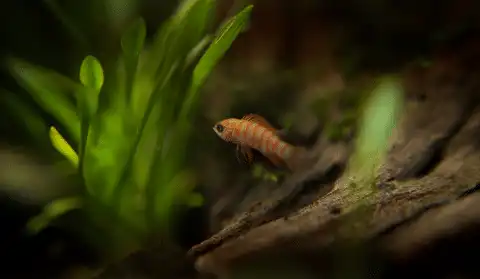Thank you for visiting! By the way… any links on this page that lead to products on Amazon and other stores/partners are affiliate links Aquarium Store Depot earns a commission if you make a purchase.
Got a small tank? Don’t worry! There are plenty of small fish options that could make your limited space just as exciting as a monster aquarium. Many species of freshwater schooling fish only grow to be a couple of inches long, making them perfect inhabitants for aquariums under 15 gallons.
Here are some of the smallest aquarium fish available for your tank!
Key Takeaways
- One of the smallest fish in the aquarium trade is the dwarf pygmy goby.
- The world’s smallest fish is believed to be Paedocypris progenetica, an unnamed fish from Sumatra.
- Small aquarium fish don’t require any additional consideration, but tank mates should have a similar temperament.
- Popular small fish include zebra danios, chili rasboras, dwarf pea puffers, and white cloud minnows.
The 21 Smallest Aquarium Fish In The Trade
Some of the smallest fish in the world can be brought into the home aquarium. What they lack in size they bring in color, movement, and excitement. Check out the video from our YouTube Channel.
It should be noted that just because these fish are small does not necessarily make them the most affordable or hardy species. Some may also be limited in availability or difficult to find.
1. Dwarf Pygmy Goby
- Scientific Name: Pandaka pygmaea
- Adult Size: 0.35-.0.45 inches
- Tank Size: 5 gallons
- Temperament: Peaceful, bottom-dwelling
To begin this list, we start with one of, if not, the world’s smallest fish species: the dwarf pygmy goby. Also known as the Philippine goby, these incredibly tiny fish max out at just under a half-inch long. They have mottled black, brown, and white colors with a typical elongated goby body.
The dwarf pygmy goby originates from muddy bottoms throughout Southeast Asia. They regularly move between freshwater and brackish conditions; many hobbyists prefer keeping them in medium salinity, but they can also be kept in purely fresh conditions.
Unfortunately, the dwarf pygmy goby is a critically endangered species and distribution is highly limited. Hobbyists are most likely to find these fish available for purchase near their natural habitats.
2. Exclamation Point Rasbora
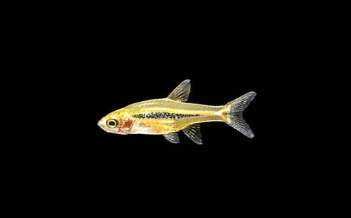
- Scientific Name: Boraras urophthalmoides
- Adult Size: 0.50-0.65
- Tank Size: 10 gallons
- Temperament: Peaceful, shy
The exclamation point rasbora is colorful and aptly named for the black-and-orange-outlined ‘!’ on the sides of its body. These fish are native to Thailand but can be found for sale throughout the aquarium industry relatively easily.
The exclamation point rasbora needs to be kept in larger groups, with most hobbyists recommending a school of at least 10 or more. This is because these fish are very shy and skittish and will find comfort in a larger school. For the same reasons, the aquarium should be densely planted with plenty of floating plants. Tank mate compatibility is also limited.
3. Chili Rasbora
Use Promo Code ASDFLIPPROMO
A great nano schooling fish. Males display brighter colors. Best in groups of 6 or more
- Scientific Name: Boraras brigittae
- Adult Size: 0.75-1.0 inches
- Tank Size: 10 gallons
- Temperament: Peaceful
The chili rasbora has gained popularity over the past few years as being one of the best freshwater species that only grow to an inch. These fish are firey-orange and will bring tons of color and movement to the aquarium.
Like most other small fish, chili rasboras are shy schooling fish that excel in a large group with plenty of vegetation. If keeping no other fish, a 10 gallon aquarium can comfortably keep a school of 20 individuals.
The chili rasbora is a relatively hardy fish that can adapt to some changes in water parameters, but good tank husbandry is a must. With excellent care, these fish can live to be 8 years old!
4. Fire Ember Tetra
- Scientific Name: Hyphessobrycon amandae
- Adult Size: 0.75-1.0 inches
- Tank Size: 10 gallons
- Temperament: Peaceful
Similar in appearance to the chili rasbora, the fire ember is bright orange. However, fire embers are hardier, less skittish, and much more affordable than chili rasboras.
Fire ember tetras originate from the Amazon River in South America. They prefer a heavily planted aquarium and a school of at least 6 or more. These small fish have been captive-bred and can be kept in a wide range of aquarium conditions.
5. Least Killifish
- Scientific Name: Heterandria formosa
- Adult Size: 0.75-1.50 inches
- Tank Size: 10 gallons
- Temperament: Peaceful
Though they’re named killifish, least killifish are not true killifish and are a type of minnow instead. This means that they are small, hardy fish that can complete a natural biotope setup or densely planted aquarium. They are also one of the few aquarium species available that is native to the southeast United States.
Least killifish are one of the smallest species of minnow available, making them a perfect addition to the nano aquarium. These are not schooling fish, but they greatly enjoy the company of others.
6. Pygmy Sunfish
- Scientific Name: Elassoma spp.
- Adult Size: 1.0-1.5 inches
- Tank Size: 10 gallons
- Temperament: Shy, live-feeders
Pygmy sunfish are sure to make a big splash in the aquarium hobby in the near future. These electric black and blue fish almost resemble a small species of cichlid, without the aggression. Instead, these fish are native to the southeast United States and display paired mating behaviors.
Pygmy sunfish are currently difficult to find for sale, though demand is growing. There is one major challenge that comes with keeping these fish though, and this is that they require a live food diet. They are ambush predators and need to hunt for prey that wiggles and moves.
The best home for a pygmy sunfish will have a live food system up and running.
7. Pygmy Corydoras
A smaller variety of Cory Catfish. Grows to less than 1.5 inches in length. A peaceful bottom dwelling fish
- Scientific Name: Corydoras pygmaeus
- Adult Size: 0.75-1.5 inches
- Tank Size: 10 gallons
- Temperament: Peaceful, bottom-dwellers
Though some of the other tiny fish on this list might be hard to find at your local fish store, the pygmy corydoras is luckily easy to find.
These small bottom-dwellers are native to Brazil and appreciate a soft substrate with plenty of live plants. They have natural brown and white colors and are easy to tell apart as females are almost double the size of males! They are very difficult to breed in the home aquarium but have been done so successfully at a commercial scale.
Pygmy corydoras are one of the few species on this list that can be safely housed with larger tropical fish. As long as they are kept in schools of at least 6 or more and are given plenty of coverage, they will do well in a traditional community tank setup.
8. Dwarf Pea Puffer
At only an inch in length, this is the smallest pufferfish you can purchase in the aquarium hobby
- Scientific Name: Carinotetraodon travancoricus
- Adult Size: 1 inch
- Tank Size: 10 gallons
- Temperament: Semi-aggressive
Maybe not the smallest fish on this list, the dwarf pea puffer is certainly the most adorable. These plump little fish are one of the only true freshwater species of puffer; most other species prefer brackish waters. Instead, these fish do best in a heavily planted freshwater aquarium.
The dwarf pea puffer might be small, but they can be aggressive. The problem is that males and females look the same to us, but males can tell each other apart. Male pea puffers can be territorial towards other males in the tank, especially during breeding periods. Because of this, it might take some time to work out a compatible male-to-female ratio.
9. Clown Killifish
- Scientific Name: Epiplatys annulatus
- Adult Size: 1.0-1.5 inches
- Tank Size: 5 gallons
- Temperament: Peaceful, predatory
Also known as the banded panchax, the clown killifish is a very interesting fish to keep. These might not be the smallest fish on the list, but they’re one of the smallest and most effective predators. The clown killifish stays just below the surface of the water, waiting for insects and other small organisms to land. When ready, they use their upturned mouths to quickly catch their prey!
In the aquarium setting, this can be replicated by offering small insects, such as fruit flies and mosquito larvae. While predators, clown killifish can be kept alongside a variety of community tank species, like tetras and corydoras. However, they are rather solitary and enjoy the company of one or two others.
10. Spotted Blue Eye Rainbowfish
- Scientific Name: Pseudomugil gertrudae
- Adult Size: 1 inch
- Tank Size: 10 gallons
- Temperament: Peaceful, shy
Possibly the most beautiful fish on this list, the spotted blue eye rainbowfish is a shimmering bluish-yellow with elongated speckled fins. Because of their appearance, these are also some of the most expensive fish listed.
The spotted blue eye rainbowfish only grows to be about an inch at mature size. They originate from shallow, slow-moving waterways throughout Southeast Asia as well as Australia. Spotted blue eye rainbows can withstand low pH levels, making them a good candidate for blackwater or biotope setups.
These fish do best in groups of at least 6 or more and as one of the only species in the aquarium. They are often kept with peaceful bottom-dwellers, including snails and shrimp.
11. Green Neon Tetra

- Scientific Name: Paracheirodon simulans
- Adult Size: 0.75-1.0 inches
- Tank Size: 10 gallons
- Temperament: Peaceful
The green neon tetra isn’t seen in the aquarium as often as the more recognizable neon tetra, but these tiny fish do well in a school in most tank setups. A few considerations are needed to keep them, though.
While tetras are seen as some of the hardiest fish in the aquarium hobby, green neon tetras are a little more sensitive to imperfect water conditions. These fish originate from exclusively blackwater conditions in South America. This means that blackwater conditions with soft, acidic water parameters need to be matched in the home aquarium. They also need heavy plant coverage, preferably with leaf litter that sustains a natural population of small foods.
12. Kubotai Rasbora
- Scientific Name: Microdevario kubotai
- Adult Size: 0.50-1.0 inches
- Tank Size: 10 gallons
- Temperament: Peaceful
One of the less common species of rasbora, the Kubotai rasbora is hard to miss! These fish are naturally neon green from Southeast Asia.
For their size, these rasboras originate from moderately-flowering waterways. This, in addition to plant life, makes the water highly oxygenated, which should be recreated in the aquarium setting with plants and air bubblers. Surface water may also be agitated as long as it’s not overpowering the rasboras.
Otherwise, Kubotai rasboras are relatively straightforward to keep as long as water parameters are maintained. They are a schooling fish that need to be kept in a group of at least 6 or more. Tank mate pairing may be difficult as other inhabitants must also be a similar size and be able to withstand a moderate water flow.
13. White Cloud Minnow
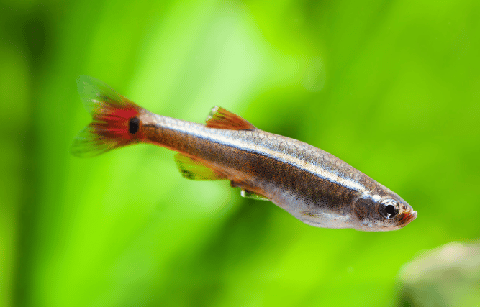
- Scientific Name: Tanichthys albonubes
- Adult Size: 1.5 inches
- Tank Size: 10 gallons
- Temperament: Peaceful, active
While many of the smallest aquarium fish are fun and cute to look at, many are shy and reclusive. If you’re looking for something small and active, the white cloud minnow might fit your next coldwater aquarium setup!
The white cloud minnow is a bold fish with a silver body, bright white horizontal stripe, and unmistakable red fins. They originate from China but have been found in other regions of Southeast Asia. Unfortunately, they are nearly considered extinct in their natural habitat.
Luckily, these are some of the easiest fish to keep in the aquarium hobby and are highly prolific! They will naturally mate when kept in a school of 6 or more. White cloud minnows are a coldwater species, which means that tank mate pairing can be tricky. They also require some water flow and are relatively active in the top and middle portions of the aquarium.
14. Glowlight Tetra

- Scientific Name: Hemigrammus erythrozonus
- Adult Size: 1.5-2.0 inches
- Tank Size: 10 gallons
- Temperament: Peaceful
You might think that glowlight tetras are artificially dyed, but these bright orange fish are all natural! These tetras are a little bigger than the other species on this list, but they’re a perfect addition to a more active community tank.
Glowlight tetras originate from South America and do best in a heavily planted aquarium with a dark substrate that lets their natural colors show. These fish are a loose schooling species and need to be kept in groups of at least 6 or more. If they’re swimmingly together in a tight school, then they might be overwhelmed by the other tank mates in the aquarium and a larger school may be necessary.
15. Dwarf Emerald Rasbora
A colorful Rasbora fish that needs large numbers for its personality to really show. Needs at least a group of 10.
- Scientific Name: Danio erythromicron
- Adult Size: 1.0-1.5 inches
- Tank Size: 10 gallons
- Temperament: Peaceful
The dwarf emerald rasbora is not a common species to see at your local fish store, but these fish complement the colors and behaviors of celestial pearl danios and other small tetras. They may also be advertised as a thick band purple zebra danio.
Dwarf emerald rasboras have a very limited range in Inle Lake, Myanmar. They are shoaling fish and the male-to-female ratio needs to be balanced. Males are slightly smaller but more colorful than their female counterparts. Because they’re so small, these fish do best in groups of at least 10 or more.
Another concern surrounding the dwarf emerald rasbora is during feeding time. Though these fish are confident in numbers, they can be outcompeted during feeding times by other more active species. They also have small mouths, which means that they might have difficulty eating some foods.
16. Borneo Sucker Loach
- Scientific Name: Gastromyzon punctulatus
- Adult Size: 1.5-2.0 inches
- Tank Size: 20 gallons
- Temperament: Active, social
Another species not commonly found for sale in the hobby is the Borneo sucker loach, also known as the spotted borneo sucker. These fish are named after the country they originate from and the small yellow spots that cover their dark body.
The Borneo sucker loach is a relatively challenging fish to keep. These loaches need high water flow, and social groups of at least 4 or more. They should have a healthy supply of natural algae available, but will also need high-quality algae wafers and flakes.
Other tank mates should be able to tolerate a more active and outgoing species. Though these loaches aren’t aggressive, other small and timid fish might be overwhelmed.
17. Zebra Danio
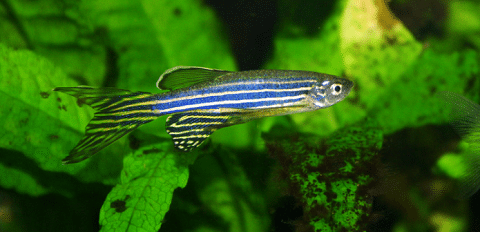
- Scientific Name: Danio rerio
- Adult Size: 1.0-2.0 inches
- Tank Size: 10 gallons
- Temperament: Active
The zebra danio is a staple fish in the aquarium hobby. While they’re not the world’s smallest fish, they’re one of the most recognizable.
The zebra danio originates from parts of Southeast Asia and especially prefers cold water temperatures. However, they have been successfully bred and adapted to the aquarium hobby for years and can now be kept in nearly every temperature range.
These fish are extremely hardy and can be paired with most fish that fit inside their preferred temperature zone. Zebra danios prefer the upper portions of the water column, where they’ll zoom back and forth across the tank in their school. Smaller, less active tank mates should be avoided.
19. Gardneri Panchax Killifish
- Scientific Name: Fundulopanchax gardneri
- Adult Size: 2.0-2.5 inches
- Tank Size: 20 gallons
- Temperament: Peaceful
One of the most colorful fish on this list, the Gardneri Panchax killifish grows well over one inch but can fill a small aquarium all on their own. Males are brighter in color, but both males and females feature bright green, orange, red, and blue coloration. These fish originate from unique marsh habitats that experience seasonal droughts throughout areas of Africa, like Nigeria and Cameroon.
Because of their changing environment, these killifish are very hardy and do well in most aquarium setups. A tight aquarium hood is necessary.
20. Scarlet Badis
A great colorful nano fish. They are known for being semi-aggressive. Best if keep solo or in pairs
- Scientific Name: Dario dario
- Adult Size: 1 inch
- Tank Size: 10 gallons
- Temperament: Generally peaceful
The scarlet badis is a perfect freshwater nano fish for hobbyists who prefer cichlid behavior. Badis are like mini-cichlids, just without the aggression!
The scarlet badis is a colorful red and blue fish that originates from India and Bhutan. When ready, males and females form mating pairs. Males can become aggressive towards each other during these times, so it’s recommended to only keep one male and female per tank.
Otherwise, scarlet badis are timid fish that will shy away from more active and overbearing species. They need plenty of plants and hiding spots to spawn and to feel safe. These fish also need a high-quality diet mixed with flake food and live food, but should not be overfed as they’re prone to obesity.
21. Emerald Eye Rasbora
- Scientific Name: Rasbora dorsiocellata
- Adult Size: 1.0 inch
- Tank Size: 10 gallons
- Temperament: Peaceful
Another less commonly known rasbora, the emerald eye rasbora is simple in color with a greenish-grey body and highlighted dorsal fin. These fish originate mainly from Thailand but can be found throughout flowing streams across Southeast Asia.
Emerald eye rasboras have peaceful schooling behaviors. They do well as a background fish in a school of 6 or more but may be timid around more active species.
Other Species
There are two species listed below that are not available for aquariums and the others are often mentioned, but we ran out of space. Let me know in the comments if we missed any fish and I’ll add them to the list.
- Midget dwarf goby
- Corfu dwarf goby
- Celestial pearl danio (AKA Galaxy Rasboras)
- Mosquito rasboras
- Bettas (AKA Siamese Fighting Fish) – They can live in small tanks but aren’t small themselves)
- Harlequin Rasbora – popular, but too big to be considered for this list
Conclusion
Wanting to keep the smallest fish in the world in the smallest aquarium possible? Many species of fish stay under an inch long, and even more stay under 2 inches long. Most species of small fish don’t require any special considerations in terms of aquarium requirements, but some may be more easily intimidated by larger and more active species than others.
It’s also important to keep in mind that many small fish are jumpers, so a tight aquarium lid is necessary!
- About the Author
- Latest Posts
I’m thrilled that you found Aquarium Store Depot! Here you’ll find information on fish, aquariums, and all things aquatics related. I’m a hobbyist (being doing this since I was 11) and here to help other hobbyists thrive with their aquariums! I adhere to a high quality Editorial Process and Review products with real life field usage and practical analysis.

